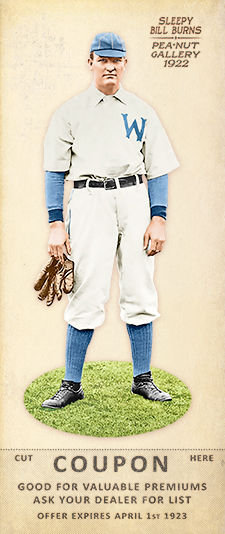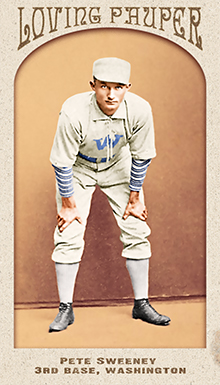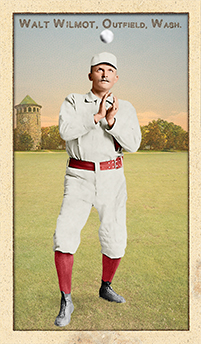
- Series: 1919 Black Sox Scandal
- City: Washington, D.C.
- Team: Senators
- League: American League
William Thomas Burns (1880-1953) was an American League pitcher who didn’t finish well. He began his career of failed finales in his rookie season, 1908, with the Washington Senators. Bill took a no-hitter into the ninth inning and got two more outs before Germany Schaefer spoiled his bid and won the game. A year later with the White Sox, and facing his former teammate Walter Johnson, Burns lost another no-hitter with one out to go. Not until Dave Stieb had the misfortune of losing (consecutive!) two-out no-nos in 1988 would such a fate befall another major leaguer. The ‘08 season was a fine one for Bill, who apparently didn’t earn his “Sleepy” sobriquet until later, when he developed a reputation for a lackadaisical demeanor on the mound. He had an outstanding 1.69 ERA in 1908, but would never win more than eight games in a season en route to a 30-52 career record.
It was his career-ending tour with the Tigers in 1912 that would prove fateful for Sleepy Bill. On May 18, teammate Ty Cobb couldn’t resist battering a maimed and abusive fan, earning a suspension from league president Ban Johnson and triggering a walk-out by the team. Detroit’s owner wanted to forfeit and Johnson threatened to fine him if he didn’t field a team in Philadelphia. Thus Burns crossed paths with Billy Maharg, who was one of the replacement players against the Athletics. Years later, the two would team up in a scheme that provided the most notorious of endings for Bill Burns: the end of any reputation for honor in baseball. He and ex-boxer, and shadowy operator Maharg, likely at the behest of the most famed gambler of his day, Arnold Rothstein, would fix the 1919 World Series. Burns met with Eddie Cicotte and Chick Gandil at a New York hotel prior to the postseason. Investigation later revealed that Burns acted with Rothstein’s chauffeur, Maharg, and claimed to be representing someone known as “A.R.” For all of the rumors and speculation surrounding the Black Sox scandal, one bit of testimony was clear. Burns told the Assistant State Attorney: “I had the hundred thousand dollars to handle the throwing of the World Series. I also told them that I had the names of the men who were going to finance it.”
- Sleepy Bill, known for carelessness as a pitcher, was a willing henchman to the biggest crime lord of the era. He displayed a carelessness for the truth, for morality and integrity, forever staining America’s Pastime
- Another footnote to the Black Sox: Jean Dubuc was a player on the 1919 New York Giants (and had also been on the 1912 Tigers). Despite having an excellent year for the Giants in 1919, John McGraw released Dubuc, unexpectedly and without explanation, before the 1920 season. Dubuc then left the country to play and, in retrospect, lay low in Canada for 1921, and returned to play minor league ball in the States in 1922, but would never again play in the major leagues. When asked later why he had released Dubuc, McGraw stated that Dubuc "constantly associated" with Sleepy Burns and suspected that the two of them, along with Hal Chase, had conspired to ensure the Giants would lose out to the Reds during the 1919 pennant chase. Further raising suspicions of Dubuc's complicity in the year-end gambling scandals of 1919, his former Giants teammate Rube Benton testified in court during the Black Sox hearings that Dubuc had been tipped to the world series' fix by an anonymous telegram that urged him to place bets on the Reds. Combining that testimony with McGraw's suspicions, many (including The Sporting News) considered Dubuc's "guilty knowledge" of the fix as evidence of conspiracy equal to that of some other scandal participants, such as Buck Weaver and Joe Jackson, but Jean Dubuc somehow escaped such judgement from Kenesaw Mountain Landis and was never formally banned from professional baseball. Dubuc would hence go on to have a successful career as a scout for the Detroit Tigers, signing Birdie Tebbetts and Hank Greenberg. Nobody knows who sent Dubuc that anonymous telegram in 1919, but the most common candidate proposed by historians is Sleepy Bill Burns.

- Series: 1919 Black Sox Scandal
- City: Washington, D.C.
- Team: Senators
- League: American League
Elmer Joseph Gedeon (1893-1941) became an unwelcome footnote to the most notorious scandal in baseball history. Judge Kenesaw Mountain Landis had permanently banned eight White Sox players in the aftermath of the 1919 World Series affair. A few months later, Landis ousted young Joe, a slick-fielding second-baseman for the St. Louis Browns. The bad boy from the PCL, who had defied Clark Griffith over his rookie assignment, had refused to get off a train in a snowstorm, and had dismissed the stately Charlottesville hometown of Thomas Jefferson and James Madison as “a rotten little mud town down in Virginia,” ended up as the “ninth man out.” Landis found Gedeon had “guilty knowledge” of the conspiracy to fix the Series. Thus ended the rising career of one of the best defensive players at his position and a canny batter, especially skilled in the hit and run.
- Gedeon played for the Senators, Yankees and Browns. His friendship with one too many White Sox players and way too many St. Louis gamblers put him in harm’s way
- Became the first of the banished players to die, at age 47, back home in California

- Series: 1880s: Loving Paupers
- City: Washington, D.C.
- Team: Nationals
- League: National League
Peter Jay Sweeney (1863-1901) played infield and outfield on the west coast beginning at the tender age of 15 with two San Francisco clubs. He moved across the bay to Oakland in 1881, then came back to Baghdad by the Bay with the SF Haverlys in 1884-85. At age 24, Pete got his big chance, joining the Washington Nationals in '88. He returned to D.C. the following season and was moved to the St. Louis Browns later in '89. They demoted him briefly to the St. Paul Apostles, but brought Sweeney back in 1890 before trading him to the Philadelphia Athletics who sent him later the same season to the Louisville Colonels. His major league tenure ended in Louisville with Pete seeing action for four clubs in a mere three years. He was far from finished with baseball, however. Sweeney had a coast-to-coast season in 1891, playing back home for Oakland and finishing the year with the Rochester Hop Bitters in the Eastern Association. Thereafter, this wanderer would roam from California League teams to the east coast and even a season with the Nashville Tigers of the Southern League. Having begun in 1879, this lifer didn't hang 'em up until concluding the 1897 campaign with the Sunbury Pirates of the Central Pennsylvania League. There was a reason he spent most of his time in the minors: he couldn't hit big league pitching. Pete's average for his four MLB clubs was a paltry .209. Yet, he could thrive in the lower levels of the game. When he left the big leagues for Rochester, Sweeney led the Eastern Association in home runs.
- Not a lot of native Californians got to play in the majors in the nineteenth century, but while playing for the San Francisco Knickerbockers in 1879, Sweeney did play alongside one early luminary: The Only Nolan. A pitcher, perhaps from Canada, Edward Nolan sported one of the great appellations in the game
- Only one teammate from the Haverlys made it to the majors: John Smith. He had a cup of coffee in 1882 with the Troy Trojans and Worcester Ruby Legs, then of the National League
Auction History
Cartophilia
Old Judge Pose: 451-1

- Series: Beginnings: 1880's
- City: Washington, D.C.
- Team: Nationals
- League: National League
Walter Robert Wilmot (1865-1929) was a switch-hitting outfielder who played for three teams over a ten-season major league career. The high-point of his tenure came in 1894, a wondrous year for hitters in general. The second season after the mound moved to 60' 6'' saw output the likes of which have not been seen before or since. Wilmot far exceeded his normal average, hits and RBI and scored 136 runs - a total that would have placed him in the NL's top-ten any other year of the decade and beyond. But the likes of Hugh Duffy, Billy Hamilton, Joe Kelley and Wee Willie Keeler were setting baseball's world on fire.
That year Hamilton's Phillies fielded the strongest-hitting outfield of all-time, averaging over .400 with sub Tuck Turner exceeding even Billy, Ed Delahanty and Sam Thompson. So where did the mighty slugging Phil's wind up? In fourth place trailing the legendary Orioles by 18 games. But it was in runs-scored that '94 stood out. In most years of the era, one or two teams might barely plate a thousand runners. But in 1894 five teams blew past that mark and four others nearly hit it. Overall, the National League squads averaged an all-time high 7.36 runs per game.
All of this left Wilmot with an outstanding also-ran year for the ages, batting .330 with 197 hits, 134 runs and 130 RBI in just 133 games. Walt broke in with Washington in 1888, spent the first half of the nineties in Chicago and wrapped up with the Giants in 1897-98. He led the NL in triples in '89 and the following campaign tied for the HR lead.
- Wilmot was the first batter to walk six times in a game (8.22.1891)
- He played beside Dummy Hoy in D.C.'s outfield
- In addition to his decade in the majors, Walt played eight minor league seasons beginning with St. Paul in 1886 and ending in Butte, MT of the Pacific National League in 1904
- His MLB stats include a .276 average with 92 triples
- Wilmot’s uniform color on this card was changed in July, 2017 from blue to red to reflect recent reliable research by Craig Brown & friends at Threads of Our Game. One card was previously released featuring a blue uniform.

- Series: Beginnings: 1880's
- City: Washington, D.C.
- Team: Nationals
- League: National League
George Quintus Shoch (1859-1937) had a decade-long career in the majors, beginning in 1886 with the Washington Nationals and ending in 1897 with the Brooklyn Bridegrooms. He compiled a respectable career average of .265. George was a valuable utility man, playing outfield, short and 2nd. He demonstrated good plate discipline, striking out only 129 times in 2,924 plate appearances. George's best year was his first in Brooklyn, 1894, where he hit .317 and struck out a mere six times in 65 games. At the close of his big league tenure, Shoch showed his usual consistency, playing in 85 games for the Bridegrooms and hitting .278. Durability and consistency were hallmarks of Shoch's career.
George began pro ball in 1885 with the Eastern League's Wilmington Blue Hens, who also played in Atlantic City, and with the Hartford Babies of the Southern New England League. He remained in the game until age 46, closing out with Binghamton and Amsterdam of the New York State League. Shoch’s last games were with the tri-city team of Amsterdam/Gloversville/Johnstown where the Jags shared their talents for three seasons in three upstate NY towns.
- For one season, 1900, George was player-manager for the Philadelphia Athletics/Harrisburg Ponies of the Atlantic League
- Henry Chadwick wrote that Shoch was “the most versatile utility man the Brooklyn club has ever had”
- Shoch's uniform color on this card was changed in July, 2017 from black to blue to reflect recent reliable research by Craig Brown & friends at Threads of Our Game. One card had been previously released featuring a black uniform.




